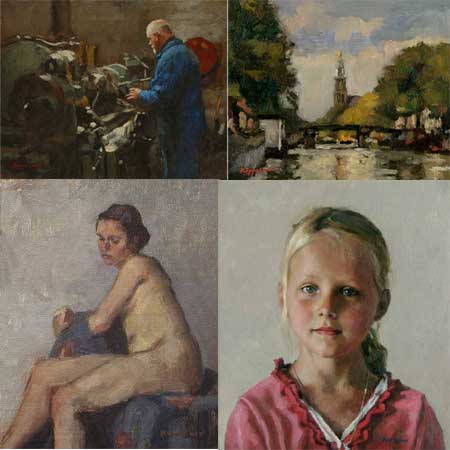
more about the art of painting...
Painting
Painting is the practice of applying pigment suspended in a carrier (or medium)
and a binding agent (a glue) to a surface (support) such as paper, canvas
or a wall. This is done by a painter; this term is used especially if this
is his or her profession. Evidence indicates that humans have been painting
for about 6 times as long as they have been using written language.
Art
In its most broad sense, 'art' is taken to indicate the assumption of an uncommonly
high level of skill by a practitioner of a particular discipline; this usage
is reflected in the phrase 'state of the art'. In other cases, 'art' might
be taken to refer to a certain set of skills, or a generalised term for discipline
itself. Thus one might have martial arts, medical arts, culinary arts, managerial
arts and so on.
The very interchangability of the term, reflected in the above broad usages, leads to challenges in arriving at an exact definition of 'art'; certainly, one must acknowledge the difficulties of arriving at an understanding of it that will satisfy all concerned parties. Essentially, the creative arts denote a collection of disciplines whose principle purpose (some might require it to be the sole purpose) is in the output of material whose creation is ultimately impelled by an interior impulse, that will cultivate certain moods or thoughts in the viewer (see General characteristics of art). By this standard, the measure of the artist's skill is in the efficacy with which the resultant output can effect this intended outcome.
As such, the term 'art' may be taken to include forms as diverse as prose writing, poetry, dance, acting, music (both performance and creation), sculpture and painting (see Currently recognized forms of art). Of these, in common parlance, the term is most commonly used to refer to the visual arts; in particular painting, drawing and sculpting. The following article will deal specifically with certain facets of both the latter definition and the broader one.
Definitions of art and aesthetic arguments usually proceed from one of several possible perspectives. Art may be defined by the intention of the artist as in the writings of Dewey. Art may be seen as being in the response/emotion of the viewer as Tolstoy claims. In Danto's view, it can be defined as a character of the item itself or as a function of an object's context.
Plato
For Plato, art is a pursuit whose adherents are not to be trusted; given that
their productions imitate the sensory world (itself an imitation of the divine
world of forms) art necessarily is an imitation of an imitation, and thus
is hopelessly far from the source of the truth. Plato, it may be noted, barred
artists from access to his ideal city, in his Republic.
Aristotle
Aristotle saw art is less of a bad light; though he shared Plato's poor opinion
of it, he nevertheless thought that art might serve a purpose in catharthis.
That is, by witnessing the sufferings and celebrations of actors onstage onlookers
might viacriously experience these same feelings themselves, and thereby purge
such negative feelings.
Art of Painting